RESOURCE CENTER
Hear the latest developments and key findings in ADHD research from the experts at TEAM ADHD
Access the most up-to-date information about ADHD from leaders in the field of psychiatric research.
The Neurobiology of ADHD
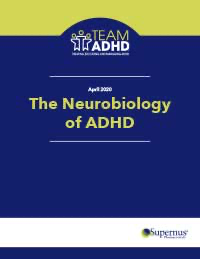
Get an in-depth look at the most prevalent neurodevelopmental disorder
Video Library
Thought Leader Videos
Neurobiology of ADHD:
Why ADHD May Predispose Patients to Common Comorbidities
Dr. Maletic, MD, MS, clinical professor of Neuropsychiatry and Behavioral Science at the University of South Carolina, School of Medicine in Greenville, SC, discusses the neurobiology of ADHD and the relevance in understanding its relationships with common ADHD comorbidities.
Hello. My name is Vladimir Maletic. I am a clinical professor of Neuropsychiatry and Behavioral Science at the University of South Carolina School of Medicine in Greenville, South Carolina. The topic of this video is the neurobiology of attention-deficit/hyperactivity disorder (ADHD), and the relevance in understanding its relationship with common ADHD comorbidities.
A good place to start our presentation is by reviewing some of the more recent genetic studies. Very large-scale genome-wide association studies comparing the genetic makeup of approximately 20,000 individuals with ADHD to that of approximately 35,000 healthy controls have pointed to some very interesting associations.1
For example, having a genetic makeup that carries a risk of ADHD is also associated with increased risk of alcohol intake and dependency, depression, mood swings, and feeling miserable, irritable, tense, and high-strung.1
This raises an interesting question – Are these tendencies towards higher risks of specific emotional behaviors and tendencies toward comorbidities such as substance use and depression actually comorbidities of ADHD? Or are they actually manifestations of the ADHD genetic underpinning itself? Hopefully, further research will offer an answer.1
To continue our discussion, I will briefly speak about the prefrontal cortical networks that are relevant to ADHD. We can begin by looking at the cognitive-executive network [animate blue text and arrows]. This network comprises interconnected cortical areas that have a role in executive function and working memory, as well as selective and sustained attention.
Furthermore, dorsal prefrontal cortical areas participate in “top-down” regulation of emotion. In addition, prefrontal cortical areas are connected to premotor cortices, where they participate in the planning of motoric activity. Individuals who have ADHD have been found to have abnormalities in these connections.2-5
The next network I want to bring up is the cortico-striatal- thalamic- cortical network [animate purple text and arrows]. This network comprises parallel loops that connect the prefrontal cortex with the basal ganglia and thalamus. The relevance of this network in ADHD is that it has a role in regulating ascending sensory information that reaches the prefrontal cortex and assigning salience to this information, as well as inhibiting inappropriate actions and motivation.5,6
Finally, connections in the cortico-limbic network [animate red text and arrows] originate from the ventral prefrontal cortex and connect with limbic areas, such as the amygdala and hypothalamus, as well as with brainstem norepinephrine nuclei that regulate the level of arousal. Dysfunction of these connections in ADHD may result in emotional lability, as well as deficits in impulsivity and motivation.4,7-9
We also know that ADHD is associated with structural changes in the dorsolateral prefrontal cortex (DLPFC) and the anterior cingulate Cortex (ACC). The images I am going to show you are from an MRI study that compared 24 adults with ADHD with 18 healthy controls.Blue coloring indicates a decrease in volume, and red coloring indicates an increase in brain volume compared to normal brains.10-12
As we can see in these images, those with ADHD had an increased volume in white matter and a decreased volume in grey matter, including decreases in the volume of the dorsolateral prefrontal cortex and cingulate [animate the labels, “DLPFC” and “CGa”].10
These are some of the most replicated findings in ADHD. What may be potential implications of these findings for ADHD? As noted previously, these areas have a key role in the so-called top-down regulation of emotion. But, in addition to emotional regulation, they’re also hubs of the cognitive-executive network, so they have a pivotal role in regulation of attention and executive function.2,10-11
Other functional imaging studies have also noted additional interesting differences between individuals who have ADHD and those who do not. For example, when ADHD subjects and controls, while undergoing functional imaging, observe photographs of strong emotional expressions (such as fear vs neutral expressions), they will have different emotional responses that coincide with changes in activation of relevant limbic areas.12
Unmedicated individuals with ADHD have more intense responses in their amygdala compared to healthy participants.12
If individuals with ADHD are treated with medication, their subsequent imaging reflects normalization of the limbic area responses to emotional stimuli. What is interesting is that these stimuli are so brief that they are not consciously registered, but nonetheless, brain responses to these stimuli can be readily observed on the MRI.12
Moving on from findings regarding limbic structure responsivity, let’s shift our focus to the role of basal ganglia in ADHD. As I mentioned previously, the basal ganglia are part of the cortico-striatal-thalamo- cortical pathways and are involved in motivation, as well as suppression of hyperactivity and impulsivity. As seen here, structural studies have noted smaller volumes of the ventral striatum in individuals with ADHD compared to controls.5,6,13
In addition, the globus pallidus, caudate, thalamus, and putamen have lower volumes in patients with ADHD, again possibly indicating a relationship with hyperactivity and impulsivity.14-16
Not only does the genetic underpinning of ADHD predispose individuals toward ADHD-associated symptomatology, functional and structural imaging findings provide evidence of corresponding brain changes that would reflect these phenomena. This brings up the question of whether there are any abnormalities in neurotransmission and the neurotransmitter pathways that innervate these particular cortical and limbic areas. For several decades, the focus has been on norepinephrine and dopamine transmission. We find that norepinephrine pathways originating from the locus coeruleus richly innervate prefrontal cortical areas, as well as limbic areas. The question is, is there any abnormality in norepinephrine and dopamine transmission in individuals suffering from ADHD?17-19
As this graphic illustrates, there appears to be an inverted U-shaped and delicate balance in the relationship between influx of norepinephrine and dopamine and prefrontal cortical function.20
If there is too little norepinephrine and dopamine flowing to the prefrontal cortex, individuals are likely to be distracted or disorganized, forgetful, and impulsive.20
If norepinephrine and dopamine input is optimal, these neurotransmitters will bind to the receptors that have a high affinity for norepinephrine and dopamine. Optimal transmission will be reflected in wakefulness, alertness, good attention, executive function, and working memory.20-23
On the other hand, if dopamine and norepinephrine input is excessive (as may be the case in extremely stressful situations or with an excessive stimulant dose), they will bind to the receptors for which they have lower affinity or that have an extrasynaptic location. Rather than being focused, individuals now become distracted, and they may be anxious (sometimes on the verge of panic attack), irritable, and may have difficulty falling asleep.20,24
In summary, ADHD is a very complex condition. Most likely, it is not a singular biological entity, but rather it represents several different biotypes that have similar manifestations. Genetic studies suggest that ADHD is an extreme expression of continuous heritable traits. The genetics of ADHD suggest that many of the traits related to emotional responses, anxiety, and possibly even substance use may be part and parcel of the genetics of ADHD, as well as its common comorbidities.1-2,5,
Furthermore, ADHD is associated with both structural and functional brain changes involving areas that participate in regulation of attention, working memory, and executive function, as well as top-down regulation of emotion. Neurotransmitters that are most involved in the pathophysiology of ADHD include dopamine and norepinephrine, although newer studies have also implicated GABA and glutamate.3-5,25-30
Finally, suggesting that ADHD and some of its common comorbidities have shared genetics and functional and structural involvement raises some questions; mainly, since ADHD itself has a propensity toward anxiety, mood dysregulation, and vulnerability toward substance abuse, are these manifestations of ADHD or truly comorbid conditions?25-30
Thank you very much for your kind attention and for being part of the TEAM ADHD educational initiative.
REFERENCES: 1. Du Rietz E et al. Biol Psychiatry Cogn Neurosci Neuroimaging. 2018;3(7):635-643. 2. Bressler SL et al. Trends Cogn Sci. 2010;14(6): 277-290. 3. Smith SD et al. Brain Connect. 2019;9(6):508-518. 4. Comte M et al. Cereb Cortex. 2016;26(1):144-155. 5. Arnsten AF et al. J Am Acad Child Adolesc Psychiatry. 2012;51(4):356-367. 6. Peters SK et al. Front Syst Neurosci. 2016;10:104. 7. Gunnar M et al. Annu Rev Psychol. 2007. 58:145-173. 8. Gupta A et al. J Neurosci Res. 2017; 95(9):1760-1775. 9. Gehricke JG et al. PLoS One. 2017;12(4):e0175433. 10. Seidman LJ et al. Biol Psychiatry. 2006;60(10):1071-1080. 11. Petrovic P et al. Behav Neurosci. 2016;10(70):1-25. 12. Posner J et al. J Am Acad Child Adolesc Psychiatry. 2011;50(8):828-837. 13.Soliva JC et al. Ann N Y Acad Sci. 2009;1167:212-220. 14. Nakao T et al. Am J Psychiatry. 2011;168(11);1154-1163.
15. Ellison-Wright I et al. BMC Psychiatry. 2008;8:51. 16. Collins AM. J Nurse Pract. 2014;10(1):16- 21. 17. Kollins SH, Adcock RA. Prog Neuropsychopharmacol Biol Psychiatry. 2014;52:70-78. 18. Glaser PEA et al. The neuropsychopharmacology of stimulants: Dopamine and ADHD, current directions in ADHD and its treatment. Jill M. Norvilitis (Ed.), ISBN: 978-953-307-868-7, InTech, http://www.intechopen.com/books/ curren t-directions-in-adhd-and-its-treatment/ theneuropsychopharmacology-of- stimulants-dopamine-and-adhd. 19. Sara SJ, Bouret S. Neuron. 2012;76(1): 130-141. 20. Arnsten AFT. CNS Drugs. 2009;23(suppl 1):33-41. 21. Berridge CW, Spencer RC. Brain Res. 2016;1641(Pt B):189-96. 22. Watson CJ et al. Sleep Med Clin. 2010;5(4):513-528. 23. Logue SF et al. Pharmacol Biochem Behav. 2014;123:45-54. 24. Yamamoto K et al. Psychiatry Clin Neurosci. 2014;68(1):1-20. 25. Faraone SV et al. Nat Rev Dis Primers. 2015;1:15020. 26. Barth B et al. Psychiatry Clin Neurosci. 2018;72(11):836-848. 28. Owen MJ et al. World Psychiatry. 2017;16(3):227-235. 29. Arnsten AF. CNS Drugs. 2009;23(suppl 1):33-41. 30. Purkayastha P et al. Curr Med Chem.2015;22(15):1850-1859. 31. Kooij JJ. J Atten Disord. 2012; 16(5):3S- 19S.
Common Comorbidities in Comorbid Complex ADHD: Prevalence, Age of Onset, Diagnosis, and Clinical Implications
Dr. Cutler, associate clinical professor in the Department of Psychiatry, SUNY Upstate Medical University in Syracuse, NY, discusses comorbid complex ADHD—prevalence, age of onset, diagnosis, and clinical implications.
Hello, I'm Dr. Andrew Cutler, associate clinical professor in the Department of Psychiatry, SUNY Upstate Medical University in Syracuse, New York. And I'm pleased to be discussing comorbid complex ADHD – prevalence, age of onset, diagnosis, and clinical implications.
Comorbid complex ADHD is very common — studies show that three- quarters of individuals with ADHD have at least one psychiatric condition, and 80% of those have more than one comorbidity.1
But why do people with ADHD have comorbidities? It’s possible that one disorder is a precursor to the other (evolving over time), it could be a risk factor for developing the other, or they may have a common genetic basis. Some comorbid disorders (such as depression and anxiety) may develop due to the impact of ADHD, making it a secondary condition.2,3
The comorbidity profile can change throughout the lifespan. In children and adolescents, studies have shown a high incidence of oppositional defiant disorder, which decreases in adulthood. However, in adults, we see problems with emotional dysregulation, stubbornness, trouble managing anger, and other negative emotions. In addition, those comorbidities that tend to be less common in childhood, such as conduct issues, anxiety, major depressive disorder, and substance use disorder, increase in incidence through adolescence, and into adulthood.
The cumulative burden of comorbid complex ADHD evolves and accumulates throughout the lifespan. For example, although oppositional defiant disorder is the most common comorbidity in children, conduct disorder and anxiety are also seen, with the impact of these, along with ADHD, resulting in low self-esteem in this age group. Moving from childhood into adolescence and adulthood, oppositional defiant disorder and conduct disorder decrease, but criminal behaviors start to show, with antisocial personality disorder becoming more common. In addition, learning delays in childhood develop into complex learning difficulties in adolescence and adulthood. With this progression, people often become demoralized and frustrated, resulting in lack of motivation and under achievement. Substance abuse comes into play as well.2,4-8
The presence of comorbidities in different age groups can complicate the diagnosis of ADHD, as symptoms of these comorbidities often overlap with symptoms of ADHD. For example, ADHD symptoms of restlessness, agitation, difficulty concentrating, and decreased attention are also seen in major depressive disorder, bipolar disorder, anxiety, substance use disorder, and sleep disorders; and the ADHD symptom of impulsivity [activate slide build] is also seen in conduct disorder, bipolar disorder, and substance use disorder.2,9
So, given the overlap of symptoms of ADHD and its comorbidities, what are the steps to ensure an accurate diagnosis? First, it's important to establish the diagnosis, by confirming that the individual meets DSM-5 criteria for ADHD. Then, you should rule out alternative explanations for the symptoms. Finally, and as we've already talked about, it's important to assess for comorbid conditions, which may affect the treatment of ADHD, as well as the diagnosis.10
For example, to differentiate ADHD from depression, it is necessary to identify which symptoms of depression overlap with ADHD and which are distinct. Overlapping symptoms include loss of motivation, problems concentrating, and restlessness or irritability. So, if your patient has any of these symptoms, it could be ADHD, depression, or both. However, if your patient has only symptoms of depression that are distinct from ADHD, such as feelings of sadness, thoughts of suicide, or changes in eating or sleeping, it is likely depression.2
Thank you for being part of this Team ADHD educational presentation.
REFERENCES: 1.Banaschewski T, et al. Attention- Deficit/Hyperactivity Disorder. Dtsch Arztebl Int. 2017;114(9):149-159. 2.CADDRA Canadian ADHD Practice Guidelines 2018. https://www.caddra.ca/wp-content/uploads/CADDRA-Guidelines-4th-Edition_-Feb2018.pdf
3.Pliszka SR. Comorbidity of ADHD with psychiatric disorder: an overview. J Clin Psychiatry. 1998;59:50-58. 4.Turgay A, Ansari R. Major depression with ADHD in children and adolescents. Psychiatry. 2006;3(4)20-37. 5.Goodman DW. ADHD in adults: update for clinicians on diagnosis and assessment. Primary Psychiatry. 2009;16(11):21-30. 6. Faraone SV et al. Attention- deficit/hyperactivity disorder. Nat Rev Dis Primers. 2015;1:1-23. 7.Harpin VA. The effect of ADHD on the life of an individual, their family, and community from preschool to adult life. Arch Dis Child. 2005;90(Suppl I):i2–i7. 8. Biederman J, et al. Adult outcome of ADHD: a controlled 16-year follow up study. J Clin Psychiatry. 2012;73(7):941- 950. 9.Kooij S, et al. Distinguishing comorbidity and successful management of adult ADHD. J Atten Disord. 2012;16:3S-19S. 1. 10. American Academy of Pediatrics. ADHD: Clinical Practice Guideline for the Diagnosis, Evaluation, and Treatment of Attention-Deficit/Hyperactivity Disorder in Children and Adolescents Pediatrics. 2011;128:1007–1022.
Treating Comorbid Complex ADHD: Part 1
Dr. Rakesh Jain, an adult, child, and adolescent psychiatrist, discusses the treatment of comorbid complex ADHD in this two-part series.
Hello, dear colleagues. It’s a true pleasure to be able to talk to you today. My name is Rakesh Jain and I’m an adult, child, and adolescent psychiatrist and a proud member of Team ADHD. Team ADHD is an educational initiative, with the main goal of creating and deepening discussion of issues of treating, educating about, and managing ADHD.
Today, I’ll address the issue of comorbidities in ADHD. Comorbidities are common in ADHD, with the most common comorbidities being oppositional defiant disorder, conduct disorder, anxiety disorders, major depressive disorder, and substance abuse disorders. As you will undoubtedly note, the pattern of comorbidities changes significantly over the course of a lifetime. In particular, depressive and substance use disorders increase in prevalence in adolescent and adult patients with ADHD.1-2
The American Academy of Pediatrics specifically includes the assessment of comorbidities in their ADHD diagnostic guidelines. Step 1 is to determine the presence of ADHD-specific symptoms; step 2 is to rule out any alternative causes of these symptoms; and step 3 is to evaluate for the presence of any comorbid disorder or disorders.3
Let’s talk about the evolving thinking regarding treatment of ADHD and its comorbidities. The older treatment paradigm was to treat any and all comorbidities first, then wait it out, and only then treat ADHD. The new paradigm suggests treating all disorders at the same time. Emerging evidence strongly supports the wisdom of taking this approach, which is to respect and treat both ADHD and all its comorbidities with equal attention.4,5
Let’s turn our attention to 1 specific comorbidity of ADHD, major depression. Having comorbid complex ADHD confers an unusually high risk of treatment resistance to antidepressants. In fact, the numbers are strikingly high, with more than a two-times higher risk of treatment resistance for patients with ADHD and major depression compared to major depression alone. That’s the bad news. The good news is that treating ADHD may reduce the risk of antidepressant resistance in this population.6
In addition, treating ADHD may reduce the risk of these comorbidities, as well as moderate negative outcomes in patients with comorbid conditions. You will notice that treating ADHD reduces the risk of substance abuse by 31%, the 3-year risk of recurrence of depression by 43%, the risk of substance abuse recurrences by 61%, and the risk of motor vehicle accidents by approximately 40%. All of these data persuade us to consider treating both ADHD and all of its potential comorbidities.7-10
Let’s shift gears and examine another issue. Treatment must address the time outside of school and work, too. As these two 24-hour clocks demonstrate, the lives of children, adolescents, and adults with ADHD are not limited to finite times during the day, but they extend to include the entire day. We clinicians must respect this 24-hour clock that all patients live by, whether these patients have comorbidities or not.4,11
With that, I thank you very much for your attention, and on behalf of Team ADHD, I appreciate you being part of this educational initiative.
REFERENCES: 1.Turgay A, Ansari R. Major depression with ADHD: in children and adolescents. Psychiatry (Edgmont). 2006;3(4)20-32. 2.Kollins SH. ADHD, substance use disorders, and psychostimulant treatment: current literature and treatment guidelines. J Atten Disord. 2008;12(2):115- 125. 3.American Academy of Pediatrics. ADHD: Clinical Practice Guideline for the Diagnosis, Evaluation, and Treatment of Attention-Deficit/Hyperactivity Disorder in Children and Adolescents. Pediatrics. 2011;128(5):1007-1022. 4.Mattingly GW, Anderson RH. Optimizing outcomes in ADHD treatment: from clinical targets to novel delivery systems. CNS Spectr. 2016;21:45-59. 5.Faraone SV, et al. Attention- deficit/hyperactivity disorder. Nat Rev Dis Primers. 2015;1:1-23. 6.Chen MH, et al. Attention-deficit hyperactivity disorder comorbidity and antidepressant resistance among patients with major depression: a nationwide longitudinal study. Eur Neuropsychopharmacol. 2016;26(11):1760- 1767. 7.Chang Z, et al. Stimulant ADHD medication and risk for substance abuse. J Child Psychol Psychiatry. 2014;55(8);878- 885. 8. Chang Z, et al. Medication for attention- deficit/hyperactivity disorder and risk for depression: a nationwide longitudinal cohort study. Biol Psychiatry. 2016;80(12);916-922. 9.Bihlar Muld B, et al. Long-term outcomes of pharmacologically treated versus non- treated adults with ADHD and substance use disorder: a naturalistic study. J Subst Abuse Treat. 2015;51:82-90. 10.Chang Z, et al. Association between medication use for attention-deficit/ hyperactivity disorder and risk of motor vehicle crashes. JAMA Psychiatry. 2017;74(6):597-603. 11.Jain R, et al. Addressing diagnosis and treatment gaps in adults with attention- deficit/hyperactivity disorder. Prim Care Companion CNS Disord. 2017;19(5):17nr02153.
Treating Comorbid Complex ADHD: Part 2
Dr. Rakesh Jain, an adult, child, and adolescent psychiatrist, discusses the treatment of comorbid complex ADHD in this two-part series.
Hello, my name is Rakesh Jain and I’m an adult, child, and adolescent psychiatrist and a member of Team ADHD. In this video, I will discuss the treatment of comorbid complex ADHD.
The excellent and highly instructive Canadian ADHD practice guidelines, CADDRA emphasize several key points. It is generally advisable to treat the most impairing psychiatric disorder first. However, you must also consider the most impairing and treatable disorders. If you have a patient with psychosis, a severe mood disorder, substance use disorders, or any type of bipolar disorder, these should be identified and likely treated prior to ADHD. Also, expression of suicidal or violent thoughts needs to be addressed as a priority. Note that these CADDRA guidelines only recommend severe mood disorders as treatment priorities. For mild or moderate depression, it is advisable to treat ADHD and its comorbidities concurrently.1
CADDRA guidelines also emphasize that ADHD treatment can contribute to reducing comorbid mood- and anxiety-related symptoms and impairment. When possible, medications should be selected that have the least negative effect on cognition, as treatment-related cognitive impairment can aggravate ADHD symptoms. Lastly, it is important to consider drug-drug interactions and adverse events when we’re choosing polypharmacy for patients with ADHD and comorbid psychiatric disorders.1
Now let’s look at the use of stimulants in ADHD. Relative contraindications include use in patients with Tourette’s syndrome, the presence of marked anxiety, bipolar disorder, or risk of substance abuse. It is also important to realize that up to 30% of ADHD patients with comorbid major depression may experience dysphoria when treated with stimulants. Rare, but severe adverse effects that can occur with stimulants include onset of tics, acute anxiety, depression, psychosis, and mania. All of these issues need to be kept in mind when we are considering stimulant medications for treating ADHD.2,3
Nonstimulant medications are not controlled substances and have a lower abuse potential. They do not usually exacerbate underlying tic disorders and can be used in children, and, for that matter adolescents and adults, with significant anxiety and sleep disorders. I might add that, in my opinion, depressive disorders follow the same paradigm as anxiety and sleep disorders when considering the use of nonstimulant medication. Lastly, mild sedative effects may actually be beneficial in patients who have aggression.4
Let’s look at differentiating depression from ADHD. There are overlapping symptoms, such as problems with motivation, problems concentrating, restlessness or irritability. There are also non-overlapping symptoms to keep in mind, including feelings of sadness or hopelessness, feeling tired or slowed down, changes in eating or sleeping behaviors, neurovegetative symptoms, and thoughts of death or suicide. Also, depression tends to be episodic, while the symptoms of ADHD tend to be continuous.1
When treating ADHD and comorbid major depression, I would like to make 4 points. Point 1 is that treatment of ADHD must be considered initially if patients present with mild depression. Two, for severe depression or suicidal risk, I do believe, and I support the CADDRA
guidelines, that treatment for depression must be the priority. Three concurrent treatment of ADHD and major depression is often required – use of both an antidepressant and ADHD medications occurs quite commonly.1
Thank you very much for being part of this educational presentation from Team ADHD.
REFERENCES: 1. CADDRA Canadian ADHD Practice Guidelines 2018. https://www.caddra.ca/wp-content/uploads/CADDRA-Guidelines-4th-Edition_-Feb2018.pdf. 2.Masi L, Gignac M. Clin Psychiatry. 2015:1(1):5;1-9. 3.Faraone SV et al. Attention-deficit/hyperactivity Disorder. Nat Rev Dis Primers. 2015;1:1-23.. 4.Daughton JM, et al. Review of ADHD pharmacotherapies: advantages, disadvantages, and clinical pearls. J Am Acad Child Adolesc Psychiatry. 2009
48(3):240-248.
Serious and Pervasive Impairments of ADHD: Altering Patient Trajectory Through Treatment
Dr. Mattingly, an associate clinical professor at Washington University School of Medicine in St. Louis, MO, discusses the consequences of untreated or inadequately treated ADHD and how early and effective treatment can change the course of this disorder.
Hello. I’m Dr Greg Mattingly, an Associate Clinical Professor at Washington University School of Medicine in St Louis, Missouri. I also serve on the Board of Directors for the American Professional Association of ADHD and Related Disorders and serve as a reviewer for the Journal of Attention Disorders.
My presentation today will document the severe consequences of untreated/inadequately treated ADHD and how early and effective treatment can change the course of this serious disorder.
The prevalence of ADHD in children and adolescents here in the United States and around the world is around 9%-11% and we know that about 4%-5% of adults will continue to have ADHD. So, it starts in childhood and tends to persist into adulthood for the majority of our patients.1-4
We used to think of ADHD being a disorder of boys. We now know that in children and adolescents, it’s about twice as common in boys as girls. In adults, it is equally common in men and women.5
The majority of our patients with ADHD don’t just have ADHD and nothing else, but frequently have ADHD comorbid with other psychiatric conditions—anxiety, tics, behavior disorders, mood disorders, and substance use disorders. In fact, comorbidity in ADHD is the rule rather than the exception.6-9
ADHD isn’t just a set of symptoms, but symptoms that dramatically impair the lives of our patients. Our ADHD patients have higher rates of comorbid psychiatric conditions, accidental injuries, academic issues, occupational issues, and relationship issues.10-15
ADHD also imparts a higher mortality rate. Studies show up to a 3-times higher risk of premature death and up to a 4- times greater risk of death from all causes in those with ADHD compared to individuals without ADHD, often due to accidents and trauma, comorbid psychiatric disorders and suicide.15-17
Of note, the risk of death significantly increased when ADHD was diagnosed at or after age 18. In addition, 82% of the individuals with ADHD who died, died most frequently as a result of unintentional injury or suicide.16-17
ADHD causes impairment across numerous domains of normal daily living. For the child, impairment is seen at school, forming peer relationships, and getting along with their family. For the adolescent and adult, impairment is reflected in increased rates of car accidents, criminal behavior, unwanted pregnancies, comorbid psychiatric conditions, substance abuse, and financial and marital issues.9,18-21
We measure the symptoms of ADHD, but how about quality of life? What do we learn when we measure the impairments that result from untreated ADHD symptoms? Untreated, our patients with ADHD have a lower quality of life. However, studies show that QoL is improved with ADHD treatment for children, adolescents, and adults. Treatment decreases ER trauma rates and emotional lability in children, and criminality in adolescents. In adults, treatment improves the ability to maintain relationships and decreases rates of depression, substance abuse, and
motor vehicle accidents.22-30
There is a new approach to treatment of ADHD that is comorbid with select psychiatric disorders. The old approach was to treat the most serious disorder first. ADHD was often considered a secondary condition and maybe not as impairing. Now, the new approach is to treat ADHD aggressively and appropriately—treat ADHD and also treat other psychiatric conditions at the same time, so an emerging holistic model of treatment.31
Thank you very much for your attention, and on behalf of TEAM ADHD, I appreciate you being part of this educational initiative.
REFERENCES: 1.Fayyad J, et al. The descriptive epidemiology of DSM-IV Adult ADHD in the World Health Organization World Mental Health Surveys. Atten Defic Hyperact Disord. 2017;9(1):47- 65. 2.Visser SN, et al. Trends in the parent-report of health care provider diagnosed and medicated attention deficit/hyperactivity disorder: United States, 2003-2011. J Am Acad Child Adolesc Psychiatry. 2014;53(1):34-46. 3. Merikangas KR, et al. Lifetime prevalence of mental disorders in US adolescents: results from the National
Comorbidity Survey Replication. Adolescent Supplement (NCS-A). J Am Acad Child Adolesc Psychiatry.2010;49(10):980-989. 4. Kessler RC, et al. The prevalence and correlates of adult ADHD in the United States: results from the National Comorbidity Survey Replication. Am J Psychiatry. 2006;163(4):716-723. 5. Faraone SV, et al. Attention- deficit/hyperactivity disorder. Nat Rev Dis Primers. 2015;1:15020. 6. Banaschewski T, et al. Attention- deficit/hyperactivity disorder. Dtsch Arztebl Int. 2017;114(9):149-159. 7. MTA Cooperative Group. A 14- month randomized clinical trial of treatment strategies for attention- deficit/hyperactivity disorder. The MTA Cooperative Group. Multimodal Treatment Study of Children with ADHD. Arch Gen Psychiatry. 1999;56(12):1073-1086. 8. Jensen CM, Steinhausen HC. Comorbid mental disorders in children and adolescents with attention-deficit/hyperactivity disorder in a large nationwide study. Atten Defic Hyperact Disord.2015;7(1):27-38. 9. Caye A, et al. Attention- deficit/hyperactivity disorder trajectories from childhood to young adulthood: evidence from a birth cohort supporting a late-onset syndrome. JAMA Psych. 2016;73(7):705-712.10. Clemow DB, et al. A review of the efficacy of atomoxetine in the treatment of attention-deficit hyperactivity disorder in children and adult patients with common comorbidities. Neuropsychiatr Dis Treat. 2017;13:357-371. 11. Dalsgaard S, et al. Effect of drugs on the risk of injuries in children with attention deficit hyperactivity disorder: a prospective cohort study. Lancet Psychiatry. 2015;2(8):702-709. 12. Chien WC, et al. The risk of injury in adults with attention-deficit hyperactivity disorder: a nationwide, matched cohort, population-based study in Taiwan. Res Dev Disabil. 2017;65:57-73. 13. Mattingly GW, Anderson RH. Optimizing outcomes in ADHD treatment: from clinical targets to novel delivery systems. CNS Spectr. 2016;21(S1):45-59. 14. Mattingly GW, et al. A clinician’s guide to ADHD treatment options. Postgrad Med. 2017;129(7):657-666. 15. Dalsgaard S, et al. Mortality in children, adolescents, and adults with attention deficit hyperactivitydisorder: a nationwide cohort study. Lancet. 2015;385(9983):2190-2196. 16. London AS, Landes SD. Attention deficit hyperactivity disorder and adult mortality. Prev Med. 2016;90:8- 10. 17. Sun S et al. Association of psychiatric comorbidity with the risk of premature death among children and adults with attention- deficit/hyperactivity disorder. JAMA Psychiatry. 2019 Aug 7. doi: 10.1001. 18. Galera C et al. Childhood and adolescent hyperactivity-inattention symptoms and academic achievement 8 years later: the GAZEL Youth study. Psychol Med. 2009;39(11):1895-1906. 19. Harpin VA. The effect of ADHD on the life of an individual, their family, and community from preschool to adult life. Arch Dis Child 2005;90 (suppl 1):i2-i7. 20. Brook JS, et al. Adolescent ADHD and adult physical and mental health, work performance, and financial stress. Pediatrics. 2013;131(1):5-13. 21. Biederman J, et al. Functional impairments in adults with self- reports of diagnosed ADHD: a controlled study of 1001 adults in the community. J Clin Psychiatry. 2006;67(4):524-540. 22. Banaschewski T, et al. Health-related quality of life and functionaloutcomes from a randomized withdrawal study of long-term lisdexamfetamine dimesylate treatment in children and adolescents with attention-deficit/hyperactivity disorder. CNS Drugs.2014;28(12):1191-1203. 23. Agarwal R, et al. The quality of lifeof adults with attention deficit hyperactivity disorder: a systematic review. Innov Clin Neurosci. 2012;9(5- 6):10-21. 24. Berek M, et al. Improved functionality, health related quality of life and decreased burden of disease in patients with ADHD treated with OROS(R) MPH: is treatment response different between
children and adolescents? Child Adolesc Psychiatry Ment Health. 2011;5:26.25. Winters DE, et al. Improvements inirritability with open-labelmethylphenidate treatment in youth with comorbid attention deficit/hyperactivity disorder and disruptive mood dysregulation
disorder. J Child Adolesc Psychopharmacol. 2018;28(5):298-305.26. Blader JC, et al. Prevalence and treatment outcomes of persistent negative mood among children with attention-deficit/hyperactivity disorder and aggressive behavior. J Child Adolesc Psychopharmacol.
2016(2);26(2):164-173.27. Lichtenstein P, et al. Medication for attention deficit-hyperactivity
disorder and criminality. N Engl J Med. 2012;367(21):2006-2014.28. Chang, Z, et al. Medication for Attention-Deficit/Hyperactivity Disorder and risk for depression: a nationwide longitudinal cohort study. Biol Psychiatry. 2016;80(12):916-922. 29. Chang Z, et al. Stimulant ADHD
medication and risk for substance abuse. J. Child Psychol Psychiatry.2014;55(8);878-885.
30. Chang Z, et al. Association between medication use for attention-deficit/hyperactivity
disorder and risk of motor vehicle crashes. JAMA Psychiatry.2017;74(6):597-603. 31. Faraone
SV, Asherson P, Banaschewski T, et al. Attention- deficit/hyperactivity disorder. Nat Rev Dis Primers. 2015;1:15020. 32. Mattingly GW, Anderson RH. Optimizing outcomes in ADHD treatment: from clinical targets to novel delivery systems. CNS Spectr. 2016;21(S1):45-59.
Team ADHD News
Read highlights from recent ADHD presentations by your peers
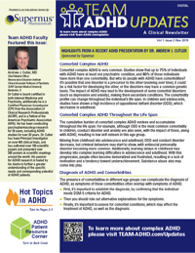
TEAM ADHD Updates: Comorbid Complex ADHD Featuring Andrew J. Cutler, MD
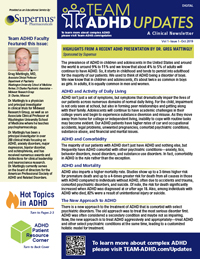
TEAM ADHD Updates: A New Approach to ADHD Featuring Greg Mattingly, MD
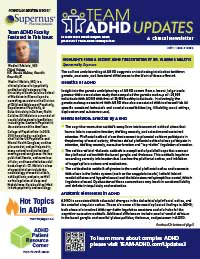
TEAM ADHD Updates: Neurobiology of ADHD Featuring Vladimir Maletic, MD
ADHD Support Organizations

For more information regarding CBT, ADHD coaching, support groups, and school support, please have your parents or caregivers visit:
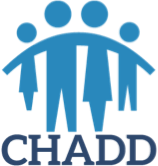



Stay in the know and access an exclusive ADHD resource
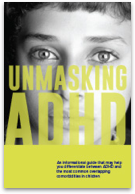
“Unmasking ADHD” can help you differentiate between ADHD and the most common overlapping comorbidities in children.
UP NEXT:


